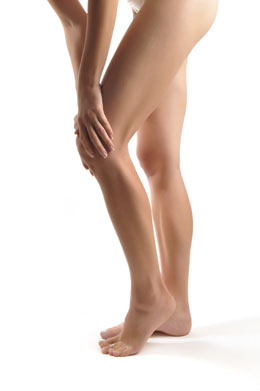Knee pain is a common complaint among old people, however many times people suffering from a specific condition experience knee joint pain. Keep reading to the know about the treatment options for this condition.

For relief from knee joint pain one can follow some home care tips and feel better in a few days. But consulting the doctor is important when a person is suffering from some specific conditions related to the pain symptom. The doctor will perform some exams and tests to diagnose the condition and recommend the appropriate treatment. Here is a list of some of the possible causes behind this condition.
Causes
A person can experience knee pain due to the following reasons.
- Arthritis
- Strains or sprains
- Anterior knee pain
- Tendinitis
- Torn ligament
- Torn cartilage
- Physical trauma or injury
- Baker's cyst behind knee
- Connective tissue disorders like lupus
- Dislocated knee cap
- Iliotibial band condition
- Bursitis
- Infection of the knee joint
- Bone tumors and Osgood-Schlatter condition
Home Care and Treatment Options
For common knee sprains or strains, one can get relief by following some home care tips, however contact a doctor in these cases:
- If the knee pain persists, after following 3 days of home care measures.
- If you have severe pain even when your knee is not exerted.
- If your knee is deformed.
- If you are having extreme symptoms like pain, tingling, swelling, numbness, or bluish calf below the affected knee.
- If your knee buckles, locks, or clicks.
Home Care Tips
- First of all take rest and avoid any activities that put stress on the knee.
- Apply an ice compress for about 15 minutes every hour for the first day, and apply it at least 4 times for a couple of more days.
- Keep your knee elevated to reduce the amount of swelling.
- To gently compress the knee, wear an ace bandage or elastic sleeve, which you can find at any pharmacy.
- Take pain killers like acetaminophen or ibuprofen for joint pain and swelling relief.
- When sleeping place a pillow below your knees.
Now let us discuss other treatments used for relief.
- Physical Therapy: The aim of physical therapy is to strengthen the muscle around the knee to prevent further injury. Physical therapy for people recovering from a surgery includes some range-of-motion knee exercises. Later on a person is advised some stretching exercises, which strengthen the calf and thigh muscles.
- Condition-related Medication: People with specific knee pain conditions like rheumatoid arthritis or gout are recommended specific medication. For example, in case of rheumatoid arthritis a person is prescribed DMARD's which are disease-modifying antirheumatic drugs.
- Surgical Treatment: There are various types of surgical treatments, the type of surgery performed depends upon the condition of the patient. Some of the options include partial or total knee replacement surgery and arthroscopic surgery which is repairing the joint using an arthroscopic technique.
- Orthotics and Bracing: Using arch supports with wedges on the inner or outer aspect of the heel can help in shifting the pressure away from the knee in osteoarthritis. It is in such a condition that using an unload brace support is advised as it also helps to ease the pressure on the knee.
- Corticosteroid Injections: These injections given in the knee help in reducing the signs of arthritis flare for a few months. Injections are not effective in all cases and have some side effects similar to oral steroid medications like water retention and increased blood sugar levels.
- Topical painkillers: Certain ointments are topically applied on the affected knee area which provide relief from pain and stiffness. Some of the topical painkillers contain cetylated fatty acids or analgesic lidocaine.
Other alternative medicine options include the following treatment.
- Acupuncture: This traditional method of pain relief is helpful for some people. Medical experts say that a person gets relief from pain in acupuncture due to the release of neurotransmitters and endorphins.
- Glucosamine and Chondroitin: These substances are available over-the-counter as nutritional supplements. These substances help in relieving pain in osteoarthritis cases.
Some prevention tips one can follow for knee pain include reducing weight in case you are overweight, strengthening of the muscles around knee, and wearing shoes that fit properly. A person should also follow regular exercising and pay special attention to the exercises which help strengthen calf and thigh muscles. You can also wear knee pads when performing those exercises which exert pressure on knees. So, follow these prevention tips to prevent any knee joint-related problems. But, if your condition doesn't get better with home care measures, then talk to your doctor for the treatment.
Disclaimer: This Buzzle article is for informative purposes only, and should not be used as a replacement for expert medical advice.


 For relief from knee joint pain one can follow some home care tips and feel better in a few days. But consulting the doctor is important when a person is suffering from some specific conditions related to the pain symptom. The doctor will perform some exams and tests to diagnose the condition and recommend the appropriate treatment. Here is a list of some of the possible causes behind this condition.
For relief from knee joint pain one can follow some home care tips and feel better in a few days. But consulting the doctor is important when a person is suffering from some specific conditions related to the pain symptom. The doctor will perform some exams and tests to diagnose the condition and recommend the appropriate treatment. Here is a list of some of the possible causes behind this condition.